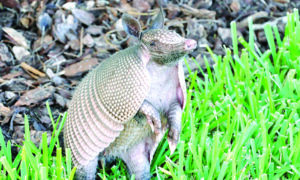By Dr. Beth Leermakers
When Nancy Black, whose neighbor has an armadillo family living under their shed, suggested I write about the funny-looking critters, I had no idea how unique and fascinating they are. Sometimes nicknamed “possum on the half-shell,” the nine-banded armadillo is the official state small mammal of Texas.

Photo courtesy of the University of Illinois College of Veterinary Medicine
The nine-banded armadillo is the only armadillo species that lives in the U.S., mostly in south-central areas. Originally native to South America, the nine-banded armadillo began migrating to Texas via Mexico in the mid-1800s. Because they don’t hibernate and can’t store body fat for insulation, these mammals can’t survive long periods of freezing weather. Therefore, they live in southern states like Texas, Georgia and Missouri.
Bullet proof but vulnerable to animal predators. “Armadillo” is Spanish for “little armored one.” Armadillos are the only mammal with an armored shell. The three-segmented shell that covers their back is made of bone and connected to their vertebrae. The shell is so strong that bullets ricochet off the armor, sometimes injuring hunters.
Heavy scales cover the armadillo’s head and legs, but the belly is protected only by tough skin and coarse hair. When they’re caught, armadillos can’t defend themselves against predators such as dogs, coyotes and mountain lions. The shell’s smooth surface allows armadillos to run through heavy, thorny brush that slows down their predators.
Leap before they look. When they’re startled, armadillos leap three to four feet straight up in the air. Biologists think this behavior startles predators, giving armadillos time to run away. Unfortunately, their vertical leap often proves fatal to armadillos who hit the undercarriage of passing cars.
Nearsighted sleepy heads. Armadillos are nocturnal creatures who sleep up to 16 hours a day. Not surprisingly, they are related to sloths and anteaters, other mammals that sleep a lot (although research has found that sloths only sleep about 10 hours per day, not 15 hours as previously thought). Armadillos sleep in underground burrows, emerging at night to forage for food. Because their vision is poor, armadillos rely on their excellent hearing and keen sense of smell for nighttime navigation and danger detection. If she senses danger while she’s eating, an armadillo may stand up on her hind legs, bracing herself with her tail. She isn’t looking for danger; she’s sniffing the air for enemies.
Baby makes four. Armadillo mothers have identical quadruplets that come from one fertilized egg and are always the same sex. The embryo starts as a single individual but then bisects twice, producing four clonelike embryos. Conveniently, female armadillos have four mammary glands — perfect to accommodate her four babies. Young armadillos can’t shed and replace their shell as they grow, so the shell grows as they do. The shell doesn’t harden until the armadillo reaches adult size.
Sink and swim. The armadillo’s heavy shell causes him to sink in water. He then rises to the surface and swims by dog paddling, with his heavy body almost completely submerged. The armadillo quickly tires. To boost buoyancy, the armadillo creates a life preserver by gulping air, inflating his stomach and intestines to twice their normal size. When he’s done swimming, it can take up to three hours to get rid of the swallowed air. Armadillos sometimes walk under water when crossing shallow ditches and narrow streams.
Armadillo digging can be a nuisance for gardeners. Armadillos dig for insects and earthworms in loose soil, using their long claws and keen sense of smell. They can smell insects who are six inches underground. While foraging for invertebrates, they dig up shallowly rooted annual plants. Armadillos dig multiple, shallow (3-4 inches deep), cone-shaped holes, particularly in the summer when sprinkler systems work overtime. Wet lawns make the soil easier to dig in and bring insects closer to the surface.
Repellants are NOT effective deterrents for armadillos. There is no toxicant or repellent currently registered or known to be effective for armadillo control. Scare tactics don’t work either.
Exclusion is your best bet. Fences can keep armadillos out of small garden beds. Armadillos can climb over and burrow under fences but fences taller than 12 inches should keep the hungry critters out of your garden. Be sure the fence fits closely to the ground to discourage armadillos from rooting under it. A fence slanted outward, with a portion buried in the ground, may do the job.
Remove debris and brushy areas from your yard. Eliminating food sources for insects may discourage armadillos.
There is seldom a quick and easy fix to any wildlife damage problem. With armadillos, adopting a “live and let live” attitude is probably the best approach.
